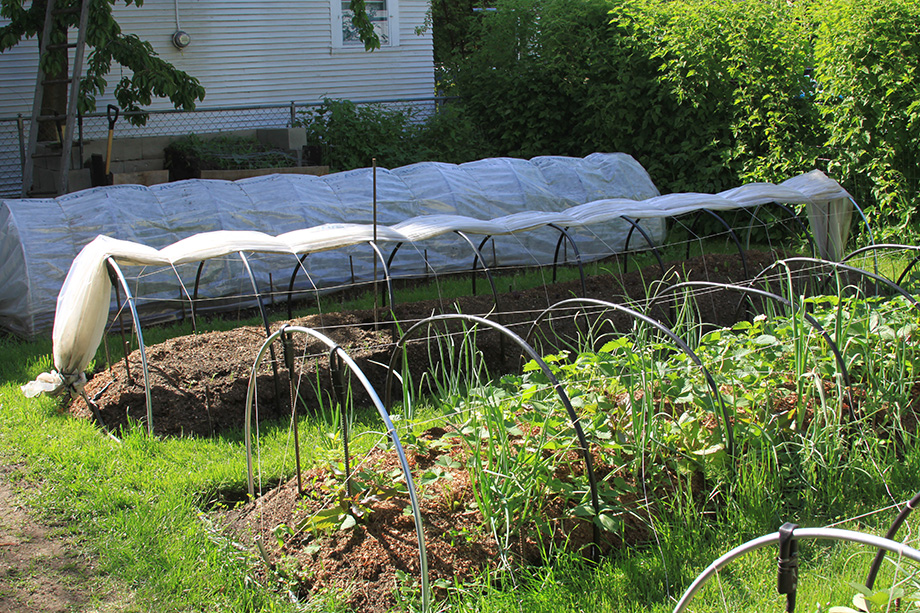Aug. 14 Column: Grow a Winter Garden

Even though Bill and I live in hardiness zone 5b, I don’t consider the garden season finished when fall frosts arrive. I love growing cold-tolerant vegetable crops through the fall and winter months. How is this possible? You’ll find out in my next garden column, which you can read in today’s edition of The Spokesman-Review: Now’s the time to jumpstart cool season crops. Or you can read it underneath my video below.
Why am I writing about this topic in August? It’s because now is the time to get those seeds started!
Choosing the right kind of crops to grow in a winter garden will be the key to your success. I look for varieties that have been marked as cold-hardy, cold-tolerant, or have a little snowflake symbol in seed catalogs! Take a look at High Mowing Seeds, Johnny’s Selected Seeds, and Territorial Seed Company. They all have nice selections to choose from.
We have a small hoop house (plastic-covered greenhouse) that Bill designed quite a few years ago. That’s what we use to grow our winter garden. But you’ll be pleased to know it’s possible to make a simple “low tunnel” (see photo above) for your own winter garden. The tunnel set-up in the photo belongs to a gentleman who lives in Spokane and he is wildly successful with it.
In this week’s video, I compare different types of row covers. You can use them to protect veggies from insects, weather and birds. Of course, it includes my report on the agricultural insect netting that we’re using this summer!
Here’s my column:
by Susan Mulvihill
In the Inland Northwest, our cold, wet spring really got the garden season off to a slow start. Because of this, you probably don’t want to even think about the coming fall and winter but now is the time to make plans for growing veggies during those seasons. No, I haven’t forgotten which hardiness zone we’re in but this is actually doable.
In 2013, I conducted my first experiment at getting veggies to grow after our traditional growing season had finished. I planted onions, carrots, spinach and lettuce since they are all cool-season crops. I placed a sheet of clear plastic over the bed and crossed my fingers. The spinach grew pretty well but the other veggies barely survived. Even so, it inspired me to try again the following year.
In 2014, we built a small, unheated hoop house, which is a plastic-covered greenhouse. I had much better success with my off-season growing project and have been finetuning my methods ever since. This fall will mark my ninth year of growing crops during the colder months.
You don’t need a hoop house or greenhouse to be successful at this. You can go with a simple, 24-inch low tunnel, which is comprised of short hoops and a sheet of clear plastic placed over them. For extra protection and durability, consider getting a sheet of 6-mil greenhouse plastic.
Even though fall doesn’t officially begin until Sept. 22, this is the time to get some of your plants started. That’s because their survival rate increases if they’ve had a chance to become established before the really cold temperatures arrive.
My most important takeaway is to choose crops labeled as “cold tolerant.” If you look through seed catalogs, you’ll discover interesting types of greens that can handle the cold much better than regular cool-season crops. Here are some examples to consider:
Komatsuna Asian greens, Astro arugula or Sylvetta wild arugula are hardy options. The spinach varieties of Matador, Patton, Tundra and Regiment are all cold-tolerant. Last winter, I grew an endive called Batavian Full Heart that performed beautifully. There are plenty of winter-hardy kale to choose from, such as Darkibor, Meadowlark, Oldenbor, Prizm, Redbor, Red Russian, Scarlet, Siberian, Starbor, Westlander, White Russian and Winterbor. Two tasty but lesser-known greens are Vit mache (corn salad) and Claytonia (miner’s lettuce).
Start your seeds as soon as possible, preferably indoors unless the seed packet recommends direct-sowing them into the garden. Wait until early September to transplant your seedlings into your designated bed. You won’t need to cover them with plastic until frosts become a regular occurrence, although kale, arugula and spinach will benefit from floating row cover to keep certain bugs away until freezing temperatures wipe them out.
Be aware that it can get quite hot under the plastic tunnel on bright, sunny days so remember to open the ends. Once you have to turn off your sprinkler system, you’ll need to hand-water your plants. I’ve found that when ice crystals form on the inside surface of the plastic, those water droplets will melt during the day and rain down on the plants. At that point, you won’t have to bring them water anymore but be sure to keep an eye on the soil moisture to be safe.
If you miss having fresh greens during the colder months, you will appreciate growing your own when most gardeners have hung up their gloves for the season.Susan Mulvihill is author of “The Vegetable Garden Problem Solver Handbook” and “The Vegetable Garden Pest Handbook.” She can be reached at Susan@SusansintheGarden.com. Watch this week’s video at youtube.com/susansinthegarden.

